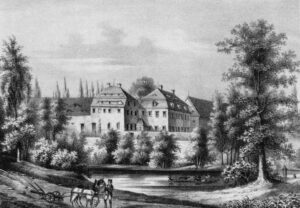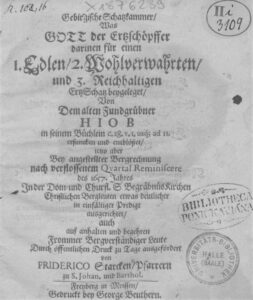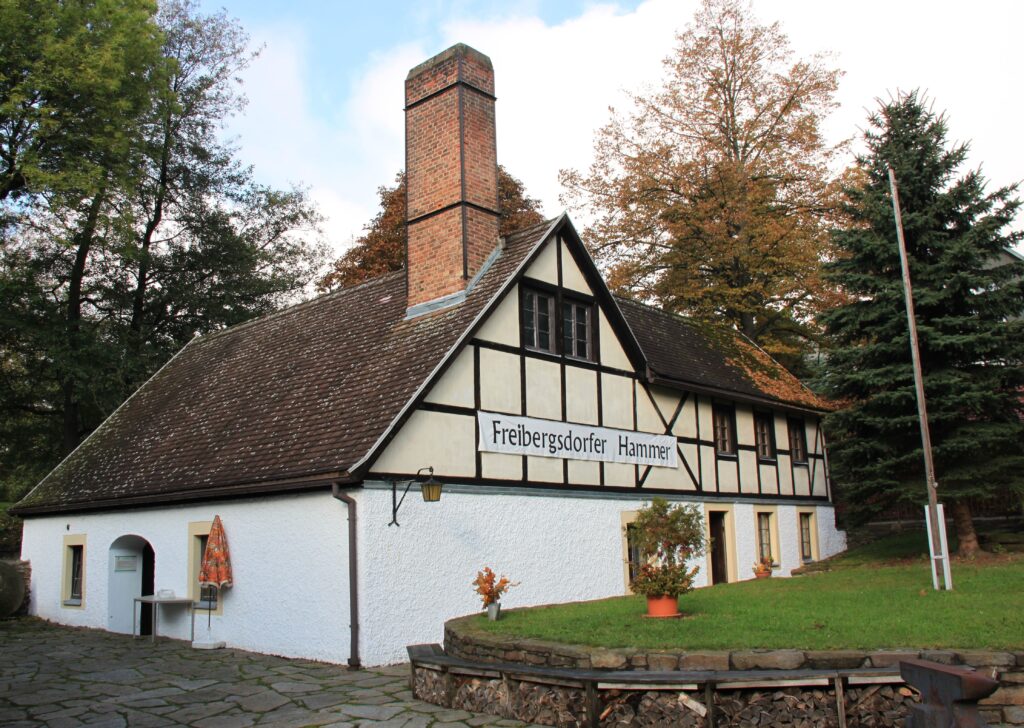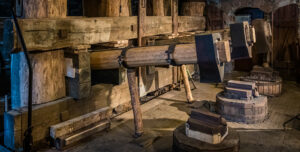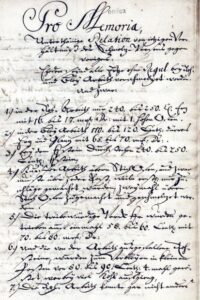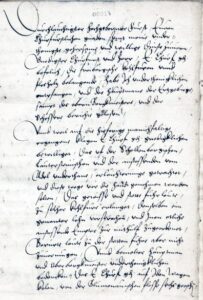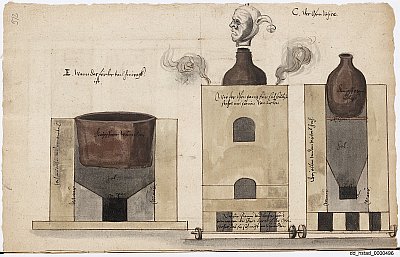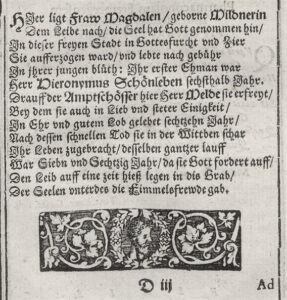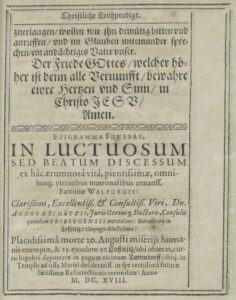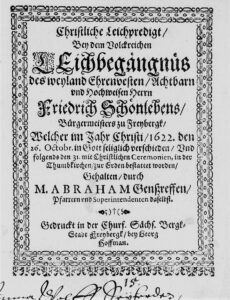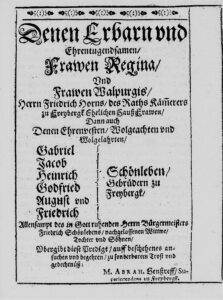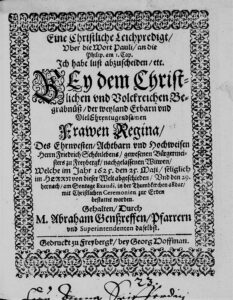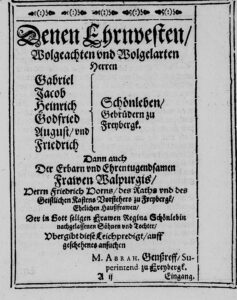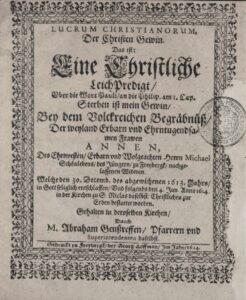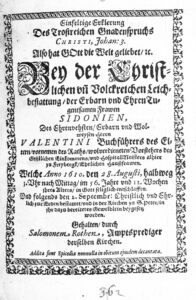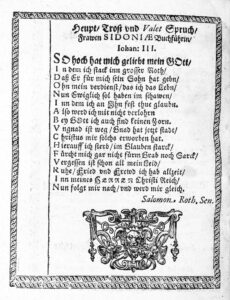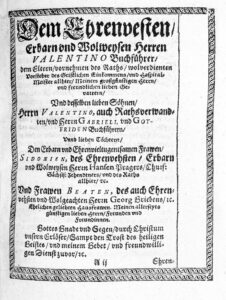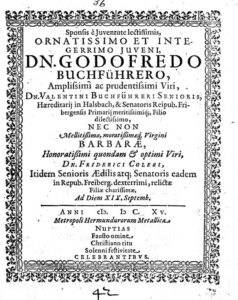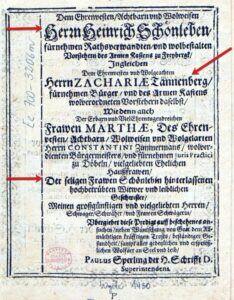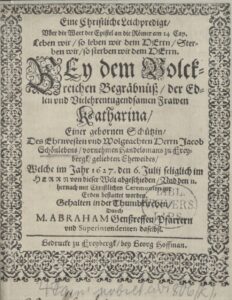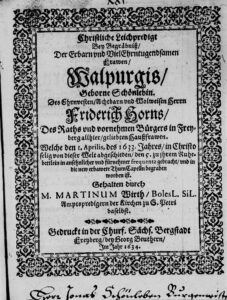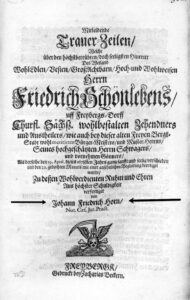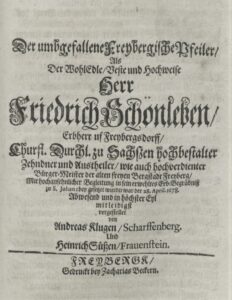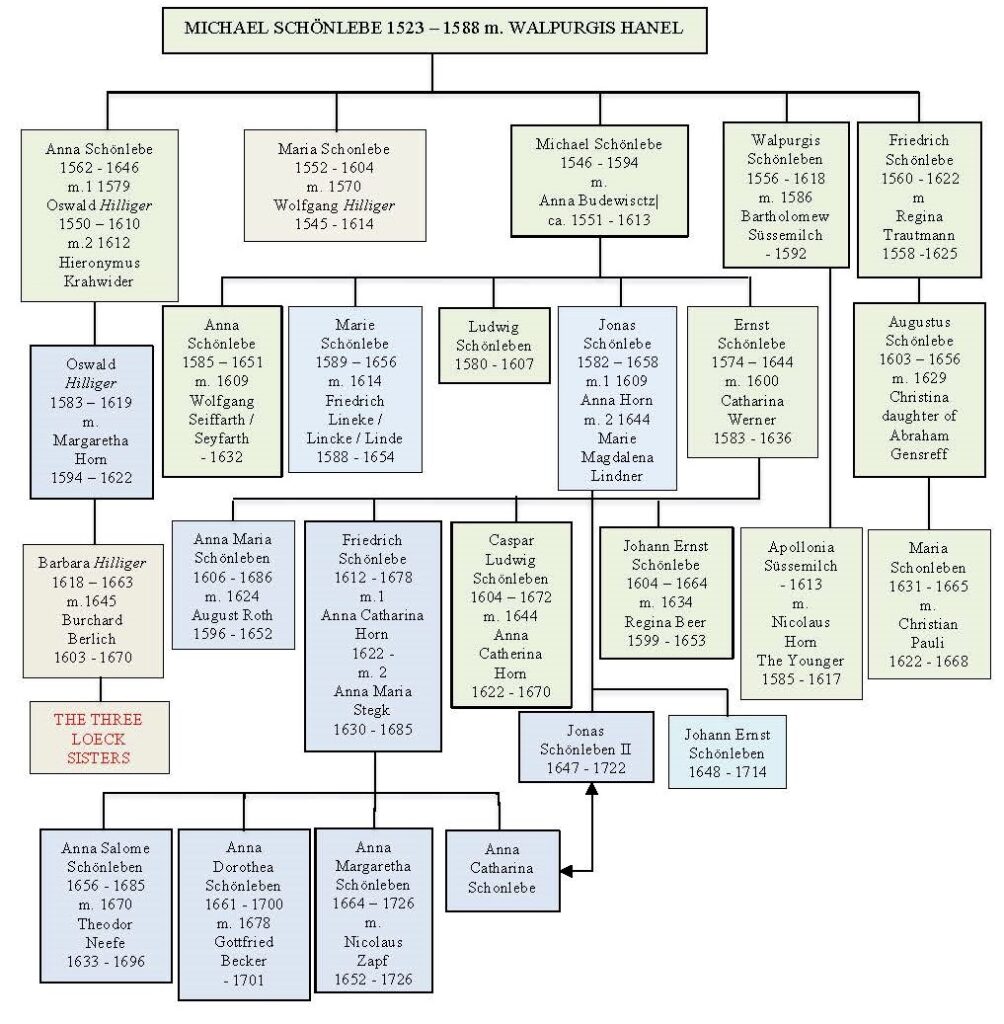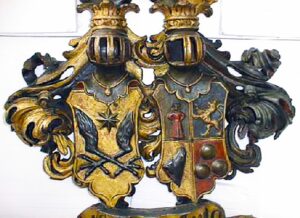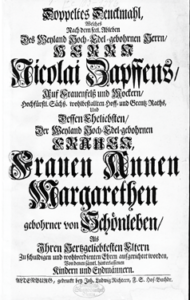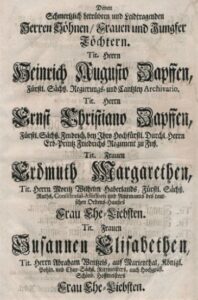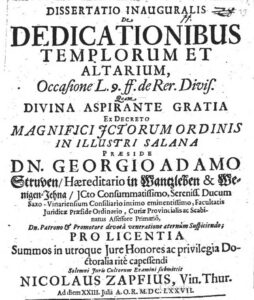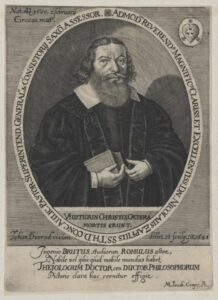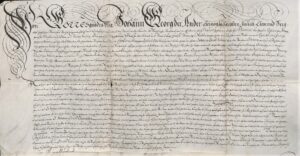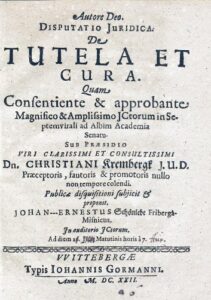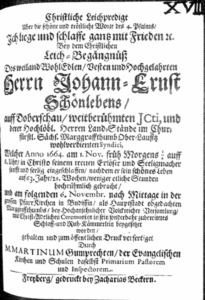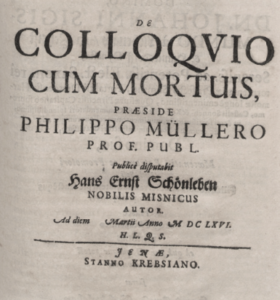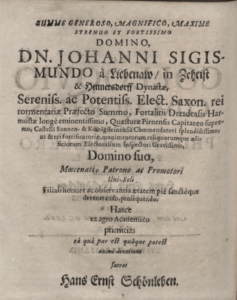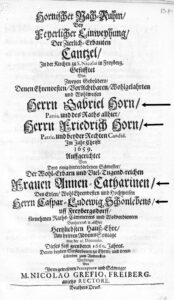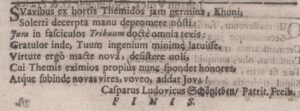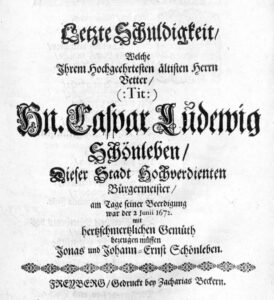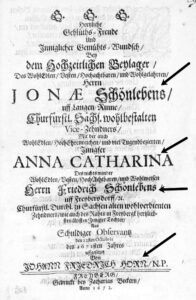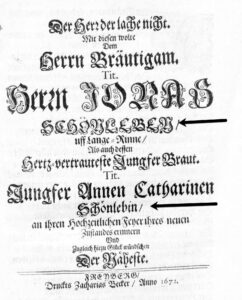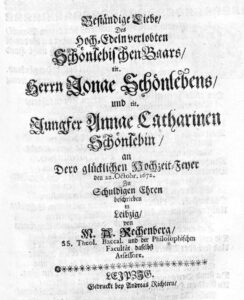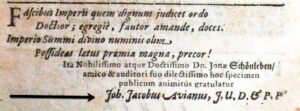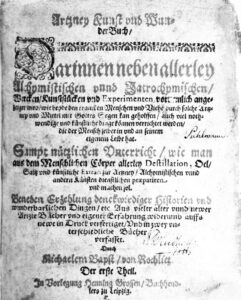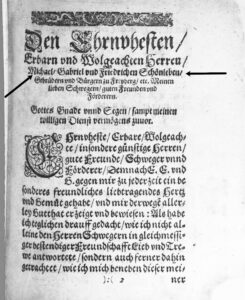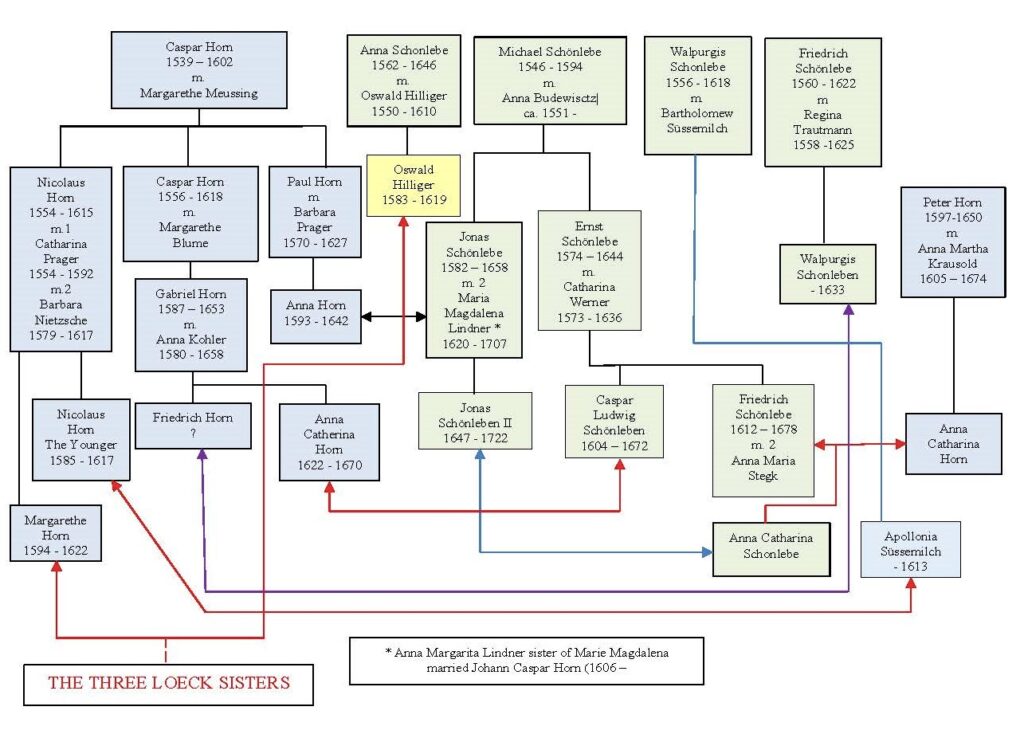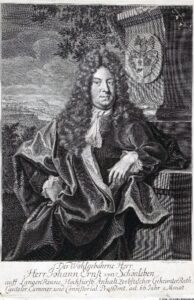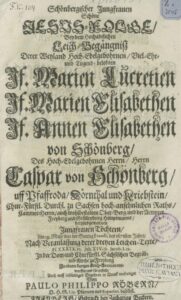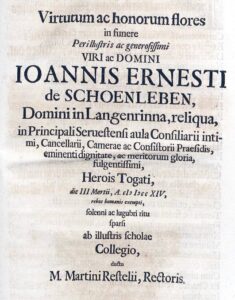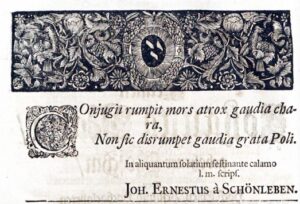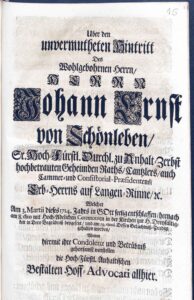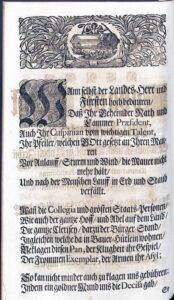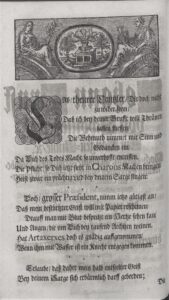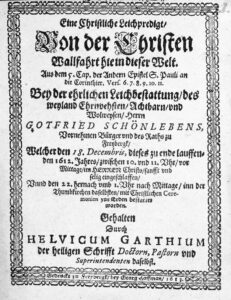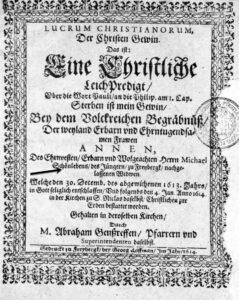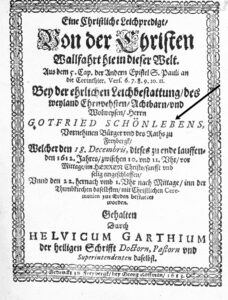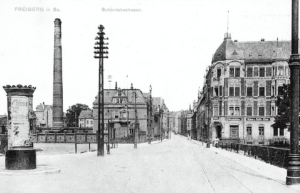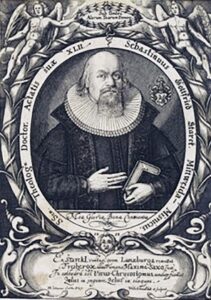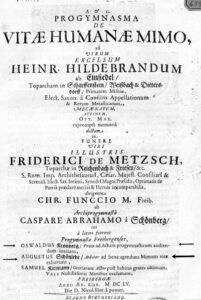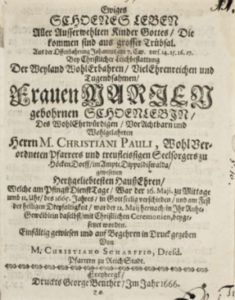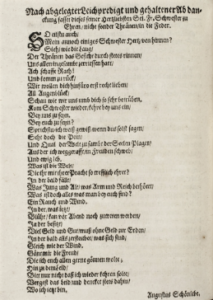This family is referred to as a ‘patrician’ family of Freiberg and was particularly influential in that city during the 16th and 17th centuries. The Three Loeck Sisters are directly descended from Michael Schönlebe I (1523 -1588) and Walpurgis Hähnel / Hänel (ca. 1525 – 1588) whose daughter Anna (1562 – 1646) married Oswald Hilliger (1550 – 1610) as shown in the charts. Walpurgis Hähnel’s father was Tobias and her mother was Walburgis Schmied / Schmidt von der Augustusburg. Anna (Schönlebe) Hilliger’s nephew was the renowned Freiberg mayor Jonas Schönlebe.
Anna (Schonlebe) Hilliger’s son Oswald Hilliger (1583 – 1619) married in 1614 Margarethe Horn (1594 – 1622). Their daughter Barbara Hilliger (1618 – 1663) married in 1645 Burchard Berlich (1603 – 1670). Their daughter Susannah Berlich married George Adam Struve and from them are descended The Three Loeck Sisters.
The Schönlebe family came to Freiberg in the 16th century and many of its members were elected to prestigious offices in the City council and also acquired such properties as the Freibergsdorf, Langenrinne, Tuttendorf, and Halsbach estates around Freiberg. Particularly prestigious was Anna (Schönlebe) Hilliger’s brother Michael Schönleben II of Langenrinne, chief iron and silver smelter, who made himself very well-known through his knowledge of mining science and inventions.
Freiberg in The Thirty Years War and the Schönleben Family
The Thirty Years War (1618 – 1648) brought death and devastation to Freiberg and the surrounding area. And, with the storms of the Thirty Years’ War, came the destruction of some of the estates owned by the Schönlebe family such as the Halsbach which was the property of Gabriel Schönlebe.
Until 1631, the city suffered mainly from billeting and war taxes, but in December 1642, the devastation and impoverishment complete, the endless battles for the city began. The Swedish army under the command of Lennart Torstensson consisted of about 6,000 troops with one hundred and eight Karthaunen and fire mortars, while the garrison defending the city consisted of only a company of dragoons and three companies of foot soldiers, altogether three hundred strong, commanded by Georg Hermann von Schweinitz and about six hundred citizens and miners led by the mayor Jonas Schönleben.
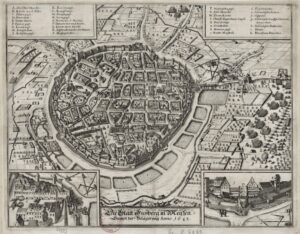
Lennart Torstensson demanded the surrender of the city but von Schweinitz and Jonas Schonlebe replied to the Swedish field marshal that they had orders to defend Freiberg down to the last drop of blood with their own. Immediately, the Swedish guns began to spew forth bullets and fireballs, so that in three hours 1,300 shots were fired at the city which, however, did little damage, as for the most part they fell in open spaces. On the other hand, the heavy artillery shells hit the ramparts and wall towers with better success, so that breaches soon arose, which, however, were filled again and again with earth sacks and manure by the miners and citizens with unbelievable contempt for death.
The Swedes suffered tremendous losses through daring raids, digging up enemy mines, and well-aimed shots, and swore that by storming the city they would kill the population to the point of infancy and level the city to the ground, but the brave defenders laughed at the threats and doubled their zeal against the foaming enemy. At one point the Swedes were able to kidnap Jonas along with 2 other citizens and held them at hostages at Laun in Bohemia and were only returned home 4 weeks later.
The town councilors fought in the midst of their citizenship, and especially Jonas Schönleben, who showed himself incessantly in the most dangerous places and encouraged the Freibergers to the bravest resistance. During the cracking of the guns and the wild cries of the fighters, their wives and children kneeled in the churches and pleaded for God’s help. And, try as they may, the Swedes were never able to capture the city. The arrival of an imperial army under Ottavio Piccolomini meant the siege of Freiberg was finally over. The city’s ability to withstand years of siege was thanks in part to the mining skills of its citizens who were able to bore long tunnels beneath the Swedish army and which could supply and sustain Freiberg as well as a connection to the court in Dresden.
By the end of 1643 when it was all over it took several decades before the consequences of the war were largely eliminated. Not only did the war claim victims, the plague also cost many lives. The population of Freiberg decreased starting in 1599 from 11,850 to only 6,500 in 1650.
After the war the Schönlebe family’s coat of arms was augmented in 1643 for Jonas v. Schönleben, because of his “cleverness and bravery” during the siege of the city of Freiberg.

The squared coat of arms of those v. Schönleben shows in the first silver field a red-clad, growing virgin with a wreath in her long hair, in the second black field a quarreling golden lion with a double tail, in the third gold a wolf head looking in to the left with a ring in the snout, and in the fourth red field with three silver cannon balls, on the crowned helmet, the maiden repeats herself between an eagle in flight transversely divided by red and white and right by black and gold.
The reputation of Jonas spread across Europe and eventually to the Scottish author J. Latchmore who wrote a book called: The young carpenters of Freiberg: a tale of the Thirty Years’ War which was published in Edinburgh by William Oliphant & Co. in 1880. This can be read here.
In 1657, a sermon celebrating the riches that Freiberg enjoyed from the mining skills of its citizens, such as Jonas and Friedrich Schönlebe (listed on the verso), was published: Gebirgische Schatzkammer Was Gott der Ertzschöpffer darinen für einen 1. Edlen 2. Wohlverwahrten und 3. Reichhaltigen Ertz Schatz beygeleget …
The Freibergsdorf Hammer Mill
The Freibergsdorf Hammer Mill is an old hammer works that was used for metalworking in the village of Freibergsdorf in the German Iron Ore Mountains. The first record of the hammer mill dates from the year 1607, when the owner of the demesne, Ernst Schönlebe, was granted water for his (iron) mill or Zainhammer.
Below, the hammers driven by the mill that helped smelt and cast the iron and made the Schonlebe family rich.
MICHAEL SCHONLEBE I der Alter (The Elder) (1523 -1588).
Michael Schönlebe I der Alter (1523 -1588) was the direct ancestor of the Three Loeck Sisters. He is described as an Oberhüttenmeister which is to say one who is in charge of the mountain huts. Exactly what this role entailed is unclear but whatever the case many sources also say that he was a “confidant” of the Elector August.
Among the records left behind by Michael are notes he wrote concerning silver mining around Freiberg, including tables for calculating the price of silver. The notes appear to have been started around 15th March 1563. Michael specifically requests for an increase in coal sales. It also includes a description of the silver melting process as practiced at the time compared with earlier ones. [Catalogued under the title: BergwerksSachen – Mscr.Dresd.J.60.a : [Sammelhandschrift]]
Michael’s job also entailed tracking the number of baskets of coal that were picked up and transported from the mines to the iron smelting mills. Each wagoner who picked up the coal was to hand over to Michael on a slip of paper, how many baskets he had picked up, from where he had picked the baskets up, and to where he had taken them, etc. Michael also advised the Elector on the type of smelting mills to be used for the different types of ore being extracted from the mines (iron, silver, gold, etc.) where to place them, and how best to construct them, etc.

However, there are in the Saxon archives writings of a court case involving allegations of “unfaithfulness” against Michel Schönlebe in the office of the chief hut administrator [Oberhüttenmeiste], as well as the arrest and interrogation of his son Michael and his cousin Hieronymus Schönlebe who are said to have been involved in these practices. They were all found innocent. By “unfaithfulness” we guess that they were accused of fiddling the books.
When his great patron the Elector August died in 1586, Michael was accused of “infidelity”. He was arrested on 03.01.1588 and taken to the Schösserei in Dresden. However, Michael did not admit to the serious accusations made against him, which later proved to be completely baseless, and he was threatened with torture. The day before the torture, he poisoned himself with arsenic. The executioner then hung him publicly from a window of the castle in the evening and later buried him under the gallows. The source for this is: Prescher, Hans Zur ältesten Geschichte des Bergbau-Portals am Haus Obermarkt 17 in Freiberg: ein Beitrag zur Genealogie Lisskirchen-Alnpeck-Weller In: Stadt- und Bergbaumuseum Freiberg. Schriftenreihe. -Freiberg (1991)10, S. 5-19. One commentator has written: “This bad thing clung to the relatives for a long time, despite proven innocence.”
His son Michael the Younger and his cousin Hieronymus Schönlebe were also arrested and accused of being involved in the same practices but were found innocent and released. [Source: Prescher; oo um 1545 Walpurgis HÄNEL Sources: Internetrecherche, Bücher Wagenbret, Webgenealogie – Landsteuerlisten Amt Wolkenstein 1551-1562, Snethlage, 2. Edb. Aachen 1991 “Familie Süßmilch”, Snethlage, 2. Edb. Aachen 1998 “Familie Schönlebe”]
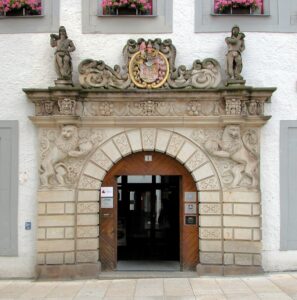
The original Freiberg Mining Office was first located at Freudenstein Castle, then in 1679, it was moved to the Schönlebe family house at No. 11, Kirchgasse. Built around 1500, this late-Gothic building was extended upward in the 19th century by one floor. On the ground floor and first floor is an interesting stellar and net vaulting ceiling. The neighbouring house, No. 13 Kirchgasse, was home to the Head Mining Office from 1679 to 1859.
ANNA SCHONLEBE (28.6.1562 – 6.2.1646)
Anna Schönlebe was the daughter of the above Michael the elder and Walpurgis and the direct ancestor of the Three Loeck Sisters. She married 1) Oswald Hilliger on 3 March, 1579 in Freiberg and after his death in 1610 she married 2) Hieronymus Krahwieder in 1612. Anna died in 1646. Prior to his marriage with Anna, Hieronymus had married Martha Buchfuhrer (died 1611) who was the daughter of Valentin and Sidonia (Schönleben) Buchfuhrer (see below). Anna’s sister Marie married Oswald’s older brother Wolfgang Hilliger.

from ore mining
Oswald Hilliger was a bell and cannon foundryman in Freiberg, and one of the richest men in the city, who later, as mayor in Freiberg, led the fight very manfully against the constitutions of Elector Augustus, which wanted to take away the old privileges from the cities according to Roman legal aspects. Hieronymus Krahwieder was born in 1555. He became his father’s successor as distributor in 1586, i.e. he was a high-ranking iron and steel official and married three times. His first wife was the daughter of the electoral secretary Hans Jenitz, Anna. In 1612 he married the widow Anna Hilliger née Schönleben. Hieronymus Krahwieder died on September 17, 1626,

HIERONYMUS SCHONLEBE
From 1595-1601 Hieronymus Schonlebe was married to Magdalena Müldner. After his death, from 1604 – 1620 she was the wife of the Freiberger Amtschössers Georg Melde. When Magdalena died the local pastor, Abraham Gensreff, took charge of the funeral sermon – Christianorum Occultatio Et Exaltatio … in which Hieronymus is mentioned and where we learn that Magdalena “fell asleep” on the 17th of March Anno 1628 and then on the 20th … was buried.
WALPURGIS SCHONLEBEN (1556 – 1618) was the daughter Michael I and Walpurgis (Hähnel) Schonlebe. She married three times: 1) Michael Richter 2) Bartholomäus Süßmilch and 3) Andreas Schütze. Only her son from her 2nd marriage Daniel Süßmilch survived her.
“Because the Jungfrauenkloster zu Freiberg was in good condition at that time, the parents placed them (their daughters) there where they stayed for 2 1/2 years, and were well educated as well as well versed in Luther’s catechism.” In 1571, on her 14th year, she married Michael Richter, Mayor of Annaberg. After 11 years of marriage, and no children Michael died in 1584, and Walpurgis moved back to live with her parents and lived with them as a widow for two years. In September 1586 she married a second time, namely Dr. Bartholomew / Bartholomäus Süßmilch from Leipzig, and after 8 years of marriage, there were 5 children: 3 sons, 2 daughters. When she died, only her son Daniel survived, who was married with one child. She had another grandchild from her daughter, who married Nicol Horn the Younger. In 1590 her second husband Bartholomew died while on a journey. She was a widow for four years and then in 1594 she married Dr. Andreas Schütze which turned out to be a 19-year marriage, with a son Andreas Schütze who was still alive when she died. Her third husband died in 1615.
Her funeral book was titled: Paradoxon Sacrum, Das ist: Die Wort des Predigers Salomonis am 7. Capitel: Der Tag des Todes ist bess … from which we learn that Walpurgis died on 20th of August, 1618, and was buried on the 23rd at the church of S. Peter in Freybergk [Freiberg].
Her funeral sermon states that: “She always got on well with her children and their young wives and twins (her daughters-in-law). She had wished very much to see her youngest son Andreas (Sagittarius) married. On Tuesday, eight days ago, she escorted the young couple to their son’s estate in Lößnitz. After they had finished their business (wedding celebration), she was happy with the children in the evening, then got up early, called the servants to work and saw the cheese maker at work when she was suddenly struck by a blow. Her language was gone. With difficulty she was carried up to her bed in her room. She died there with her son Andreas Schütze on 20th August 1618, 62 years old, and was “welcomed in the church” in Tuttendorf on the 23rd of August.
FRIEDRICH SCHONLEBE (1560 – 1622)
Friedrich Schönleben (1560 – 1622) (see chart) was the son of Michael Schonleben I the Elder and Walpurgis Hähnel and the brother of Anna (Schonleben) Hilliger and thus he was the Three Loeck Sister’s Nth great uncle. On 27th September 1585, he married Regina Trautmann (1558 -1625). When Friedrich died a funeral book was published:
In 1625 when Friedrich’s wife Regina (Trautmann) died another funeral sermon published to mark the occasion:
The funeral book lists the following sons: Gabriel, Jacob, Heinrich, Godfried, August, and Friedrich and one daughter Walpugis who married Friedrich Horn.
LUDWIG SCHÖNLEBEN (1580 – 1607)
On 4th February 1607 Ludwig Schönleben, the brother of the Three Loeck Sisters Nth grandmother Anna, was “ … shot in a hostile manner by several murderers and road robbers near Weißwasser in Lusatia … and was buried in the earth on the 9th of February”. We learn this from the as-yet-to-be digitized funeral book titled: Christliche Leich-Predigt. Bey dem Volckreichen Trawerbegängnüs Des … Herrn Ludwigk Schönlebens von Freybergk. Welcher den 4. Februarii dieses 1607 …
MICHAEL SCHOENLEBEN II (1546 – 1594) [The Younger]
Michael D. J. (II.) Schönleben, (* Freiberg (1546), + Freiberg 4.8.1594) Hüttenraiter in Freiberg. He was the brother of the Three Loeck Sisters’ Schönleben ancestor Anna (Schönleben) Hilliger. He worked for his father who was the famous hut keeper administrator, Michael Schönleben I the Elder.
He was Electoral Saxonian Hüttenraiter until 1583 and was also involved in the same lawsuit against his father in 1588, but like the others involved, he was able to prove his innocence. He had landed property, since 1577, in the Vorwerk “Lange Rinne”, which he bought for 3,500 fl. and called himself “Herr von Langerinne”. He also bought the Steitan estate in 1584 for 3,300 fl. He married at Freiberg in or around 1572 Anna Büdewitz. But at the age of only 48 he died on 4 August 1594.
When the younger Michael Schönlebe’s wife, Anna Büdewitz, died in 1613 a funeral book was published under the title: Lucrum Christianorum, Der Christen Gewin. Das ist: Eine Christliche Leich Predigt Uber die Wort Pauli an die Philip … which tells us that she died on the 30th December 1613 and was buried on 4th January 1614, in the church of S. Nicholas. The service was held by Abraham Genßreff, pastor and superintendent.
SIDONIA (SCHÖNLEBEN) BUCHFÜHRER (1554-1610)
Sidonia (Schönleben) Buchführer, 1554-1610, was the sister of the Three Loeck Sisters Nth great grandmother Anna (Schonlebe) Hilliger. On May 29, 1571, she married at the age of 17 Valentin Buchfuhrer, with whom she had 9 children. Sidonia died in 1610, and a funeral book under the title: Einfeltige Erklerung Des Trostreichen Gnadenspruchs Christi, Johan: 3. Also hat Gott … was published. From the title we learn that Sidonia’s husband, Valentin, was head of the Freiberg city council and as such received a well-deserved clerical income. He was also the ‘master’ of the hospital at “Freybergk”. Sidonia died on 28th August and then on September 2nd was buried in the church of S. Peter.
Valentin Buchfuhrer, was born in 1552. His father died when he was six years old and so he was raised by his older brother Kaspar, then by D. Hieronymus Weller from 1558, and after that he went to grammar school, where his musical talent was particularly praised. In 1568 he went to Leipzig to undertake a commercial apprenticeship. In 1570 he returned to Freiberg where he became a citizen. By profession he was a Kramer. In 1596 he sold a valuable silver cup to the city council, which the council dedicated to the famous master builder of the electoral burial chapel in Freiberg Cathedral, Maria Giovanni Nosseni. Valentin also lent a lot of money and therefore got involved in many court cases. He invested his fortune in real estate, he bought the farm in front of the Meißnische Tor from his stepfather Chilian Steck in 1581 and in the same year the house at Obermarkt 17 (the highest on the Obermarkt with the famous mining portal). Valentin died on April 16, 1616, in his house at Obermarkt 2. and a funeral sermon was published. Before his death he donated 1,250 thalers, and from the interest of 40 thalers was supposed to be paid annually to the teachers and preachers on Valentine’s Day, February 14.
In 1615 Valentin and Sidonia (Schönleben) Buchfuhrer’s son Gottfreid Buchfuhrer (1594 – 1643) married Barbara the daughter of Friedrich Coler / Kohler, and two nuptial books were published: Sponsis e Iuventute lectissimis, Ornatissimo Et Integerrimo Iuveni, Dn. Godofredo Buchführero … Dn. Valentini Buchführeri Senioris … and …. Epithalamia, Ad Solennia Nuptiarum Virtute Atque Integritate Ornatissimi Iuvenis Dn. Godofredi Buchführeri …. The ceremony was officiated by Johann Horn and Barbara’s brother, Sigmund Coler, contributed a verse.
Another son, Valentin (1574 – 1640), married Barbara Prager the widow of Paul Horn and the mother of Anna Horn who married Jonas Schonlebe I. Barbara died on 5th April 1627 and a funeral sermon was published: Christliche Leichpredigt Uber das Sprüchlein … From this we learn that she was buried on the 8th April in the renovated chapel of the Thumbkirchen.
The Buchfuhrer family was awarded a coat of arms by Emperor Charles V at the Reichstag in Regensburg on March 25, 1541. It was described as a gold-colored shield where the front part of was a black horse standing upright, holding its hooves forward to jump. On the shield is a helmet decorated with golden crests, on which the black horse can also be seen.
HEINRICH SCHONLEBEN (1596 – 1657)
Heinrich was the son of Friedrich and Regina (Trautmann) Schönlebe. Like so many in his family he had a place on the Freiberg city council as Ratskämmerer (1650).

On October 20th 1618, Heinrich married Magdalena Tannenberg (1597 – 1642) and for the occasion the composer Johann Christoph Demantius wrote some music (an epithalamium) to mark the event titled: Hochzeitlicher Davidischer Ehe-Segen (Wol dem, der den Herren fürchtet) for eight voices (Freiberg: Georg Hoffmann). Choeurs de cérémonie — Pour le celebrat d’Heinrich Schönleben: for 8 voices. A wedding book too: Honori Amorum Conjugalium Ornatissimi Juvenis, Domini Heinrici Schönleben … (not yet digitized).
Magdalena was the daughter of Zacharias Tannenberg (†1603) and Margarethe Horn. Margarethe was the daughter of Martin Horn and Katharina Vogel. Magdalena’s sister Anna Tannenberg (1592 – 1638) married on 8 June 1610 to Johann Lindner (1584-1662).
In 1642, when Magdalena died, a funeral book was published titled: Flagrantissimum Christiani Moribundi Desiderium, Das ist: Eines Sterbenden Christen inbrünstiges Verlangen … which stated that Magdalena died on the 6th October and was buried on the 11th in the Newen Chapel at the Cathedral Church.
We also learn from the title Heinrich Schönleben belongs to the city’s ‘noble council’ and is the custodian for the poor men’s welfare Freiberg. One of the contributors to Magdalena’s funeral book was Caspar Rudolph Schönleben. Caspar is recorded as owning a house that was the former military hospital.
JACOB SCHONLEBE
Jacob was the son of Friedrich Schönlebe (1560 – 1622) and Regina Trautmann (1558 -1625) and brother of the above Heinrich. He married Katharina Shutz on 25th October 1625. Katharina, died in July 1627, some two years after their marriage, and a funeral book was published under the title: Eine Christliche Leichpredigt Vber die Wort der Epistel an die Römer … Bey dem Volckreichen … he is described as noble tradesman from Freybergk.
WALPURGIS SCHÖNLEBEN ( – 1633)
Walpurgis was the daughter of Friedrich Schönlebe (1560 – 1622) and Regina Trautmann (1558 -1625). Walpurgis married Friedrich Horn. He was the son Gabriel Horn and Anna Köhler. In 1633 Walpurgis died and a funeral book was published (not cataloged on WorldCat but digitized as Deutschland, Saxony, Frei…eichenn predigten 1614-1661 Band 08 LP 21 (1633)).
In 1659, when Friedrich Horn died, a funeral book was published with the title: Güldner Lebens-Quell, daraus … geschöpffet … Friedrich Horn : bey volckreicher beerdigung … eröffnet … Another funeral book: Güldener Lebens-Quell C.J. daraus ihm selbst den Trost Der Aufferstehung und des Lebens/ wieder Des Grabes- und des Todes Schrecken Durch wahren Glauben geschöpffet Der … Friedrich Horn … includes not only mention of Friedrich but other family members such as Caspar Ludwig Schönleben and his wife Anna Catharina born Horn. As well as Justina Horn wife of Nicolas Grefio.
FRIEDRICH SCHONLEBE (1612 – 1678)
Friedrich Schönleben (born September 30, 1612 on the Freibergsdorf manor; † April 19, 1678 in Freiberg) was a Saxon lawyer, electoral Saxon civil servant at the Freiberg Mining Authority and mayor of the free mining town of Freiberg. He was also heir and feudal lord of Freibergsdorf.
Friedrich Schönleben was the son of Freiberg councilor and manor owner on Freibergsdorf, Ernst Schönleben (born June 10, 1574 in Freiberg; † December 21, 1644 in Freiberg) and his wife Catharina Vogel born Werner (born September 13, 1583; † March 24, 1636 in Freiberg), daughter of the councilor and city treasurer of Bautzen, Hieronymus Werner and widow of Paul Vogel. He was the great nephew of Anna (Schönlebe) Hilliger, the direct ancestor of the Three Loeck Sisters.
Friedrich married twice: first to Anna Katharina Horn and second Anna Maria Stegk (1630 – 1685). Some sources claim that Anna Maria’s mother was Salome Horn (1612 – 1633) whose father was Wolfgang Horn the brother of Nicolaus Horn the Younger. We are not so sure.
Friedrich Schönlebe died on April 20, 1678, leaving behind an underage son, who was named as the guardian of the consultant Johann Bodner.
His mother Catharina brought the Freibergsdorf manor into the family, which was previously owned by her first husband, Paul Vogel. Schönlebe’s mother Catharina is observed to have followed the manor’s protocol on January 3, 1602, when she: “… gave the whole community a white twill sheet of 21 cubits to form a shroud.”
Friedrich Schönleben had the following siblings:
- Johann Ernst the Elder (1601–1664), eldest son, studied at St. Afra, studied law, was state syndic of the Upper Lusatian estates in 1644, court counsel in Bautzen, gentleman on Doberschau. ⚭ Regina Beer.
- Caspar Ludwig (1604–1672), was a merchant in 1644, later councilor and mayor of Freiberg ⚭ Anna Catharina Horn (1622–1670).
- Anna Maria (1606–1686) ⚭ 1624 August Roth (1596–1652), Saxon factor of the Saigerhütte Grünthal.
- Hieronymus (around 1614 – before 1644), youngest son, died in his youth.
Life and work: After school and studies, Schönleben returned to his father’s manor, which his father leased to him in 1636 after the death of Schönleben’s mother. He tried to rebuild the estate, which had been badly damaged during the Thirty Years War. His father, Ernst Schönleben, withdrew from public life as a widower and remained unmarried.
In 1644, when his father died, Schönleben was the administrator of the Electoral Saxon court in Großschirma in the Freiberg court office. Schönleben was also the elector’s tithe collector and distributor. As such, he was the appointed tax finance officer of the elector for Freiberg. His job was to collect the taxes, the so-called “sovereign tithe”. The position of the tithe collector was a position of trust because it ensured that taxes were collected in accordance with the law and that fraud and tax evasion were prevented. Schönleben was also largely responsible for deciding how the tithe was to be used.
Friedrich died on 19th April 1678 and a funeral book was issued to mark the occasion: Der umbgefallene Freybergische Pfeiler: Als Der … Herr Friedrich Schönleben Erbherr uf Freybergsdorff … which describes Friedrich as a “Pillar of Freiberg” and the Hereditary Lord of Freybergsdorff and that his burial took place on April 28th.
Another funeral book for Friedrich was titled: Mitleidende Trauer-Zeilen Welche über den höchstbetrübten doch seeligsten Hintritt Des … Herrn Friedrich Schönlebens. The funeral ceremony was conducted by Johann Friedrich Horn (brother of Anna Catherina Horn who married Friedrich’s brother Caspar Ludwig).
ANNA SALOME (SCHÖNLEBEN) NEEFE (1656 – 1685)
Anna Salome was the daughter of Friedrich Schönleben (1612 – 1678) and Anna Maria Stegk (1630 – 1685). She married Theodor Neefe on 20th September 1670 and they had the following children: Ernst Friedrich, Paul Ehrenfried, Dorothee Sophie, and Dorothee Salome. However, Anna Salome died in 1685 and on 15th January 1686 Theodor married Regina Elisabeth Seyfried. Prior to both these marriages Theodor had married Rosina Kettner in 1660. Their wedding book had the title: Bona Verba, qvæ, Archinympho Sponsum, Virum-Juvenem … Dn. Theodorum Nefium, LL. Cultorem, & Reipublicæ Chemnicensis Senatorem bene-merentem, & Sponsam Virginem … Rosinam … Dn. M. Hermanni Kettneri, …
In 1695 Johann Wilhelm Hilliger conducted Theodor’s funeral service under the title: Einen rechtschaffenen Bürger-Meister stellet bey dem … Leichen-Begängnis des … Theodori Neefens .. from which we learn that he died on 7th February and was buried on the fourteenth of that month and was a “ … well-deserved oldest citizen-master, present here in Chemnitz.”
The arms of Neefe (left) and Schonlebe.
ANNA MARGARETHA (SCHONLEBEN) ZAPF (1664 – 1726)
Anna Margaretha was the daughter of Friedrich Schönleben (1612 – 1678) and Anna Maria Stegk (1630 – 1685). She married Nicolaus Zapf (1652 – 1726). He was the son of the renowned Protestant theologian, orientalist, university professor, and general superintendent in Weimar, Nicolaus Zapf (1600 – 1672).
Upon Anna Margaretha’s death in 1726 several funeral books were published such as: Doppeltes Denckmahl, Welches Nach dem seel. Ableben Des Weyland … , and Die in Bekümmerniß durch die göttliche Tröstung ergötzte Seele An der Person der … Frau Anna Margaretha gebohrner von Schönleben … which was dedicated to her memory by her “left behind children”.
Nicolaus Zapf was a lawyer whose law dissertation: Dissertatio Inauguralis De Dedicationibus Templorum Et Altarium, Occasione L. 9. ff. De Rer. Divis. [1677] was supervised by Georg Adam Struve.
When Georg Adam Struve’s sister Anna Maria died in 1666, Nicolaus Zapf conducted the funeral service which was published under the title: Triunum Christianorum. das ist Gottseliger Frommer Christen Größeste Haabe steter Trost und bester Theil welches alles …
ANNA DOROTHEA (SCHÖNLEBEN) BECKER (1661 – 1700)
Anna Dorothea Schönleben was the daughter of Friedrich Schönlebe (1612 – 1678) and Anna Maria Stegk (1630 – 1685) and the wife of Gottfried Becker whom she married on 18th November 1678 at Freyberg. When Anna Dorothea died a funeral book was published: Eines betrübten Kindes Gottes in Jesu Frölich vollendeter Lauff : Zu öfentlich-Solennen Andencken Der … Frauen Annen Dorothee gebohrner Schönlebin … The second page appears to show her children which were many. The title of the book describes Gottfried as a government official in Meissen.
Gottfried Becker may have been responsible for the book titled: Discursum, de politico simulante, præside viro præclarissimo dno. M. Christiano Faselto ampliss. facult. philosoph. adjunct. … in electorali ad albim publicæ eruditorum censuræ sistit Gottfried Becker Stolpensis misn. ad d. 1. decemb. anni Christiani 1666.
JOHANN ERNST SCHÖNLEBEN the Elder (09.04.1601-01.11.1664)
Johann Ernst the Elder, was a son of Ernst Schönlebe (1574 – 1644) and Catharina Werner (the widow of Paul Vogel) and a grandson of Michael I der Alter, who also made a significant contribution to mining at Freibergsdorf. He studied law at St. Afra, and was state syndic of the Upper Lusatian estates in 1644, a court counselor in Bautzen, and later a gentleman at the manor of Doberschau. He married Regina Beer.
In 1657 the Elector Johann Georg II of Saxony granted Johann Ernst, Land Syndic of the Margraviate of Upper Lusatia, and his brothers Caspar Ludwig and Friedrich, Mayor of Freiberg, the village and manor Doberschütz (Doberschitz). One of the witnesses to this was Burchard Berlich of Wegefarth.
Augustin Leyser was born the son of Professor of Law Wilhelm Leyser II and his wife Christina (1652–1711). At the age of six he lost his father, so that the Chancellor Johann Ernst von Schönleben directed his upbringing. This sent him to the monastery school in Berge near Magdeburg and in 1697 to the grammar school in Gotha, etc. …
Below, three books in which Johann Ernst the Elder appears along with Peter Theodoricus who, after his first wife had died of the plague, married on 27 October 1612 Margaretha Hilliger (born 4th June 1592 in Freiberg / Saxony;. † 2nd October 1633 in Großlöbichau), the daughter of the Freiberg alderman Oswald Hilliger (born January 18, 1550 Freiberg, Saxony; † November 11, 1610) and his wife Anna Schönleben (* 1562 in Freiberg / Saxony; † 6th March 6, 1646).
In 1664 when Johann Ernst the Elder died several funeral books were published including: Christliche Leichpredigt Uber die schöne und tröstliche Worte des 4. Psalms Ich liege und schlaffe gantz mit Frieden … Bey dem … Leich-Begängnüß Des … Johann-Ernst Schönlebens … [left] and – De Colloquio Cum Mortuis, Praeside Philippo Müllero Prof. Publ. Publice disputabit Hans Ernst Schönleben Nobilis Misnicus. Ad diem Martii Anno MDCLXVI. Jenae, 1666.
When Johann Ernst the Elder’s wife Regina (born Beer) died on 24 August 1653, a funeral book was published under the title: Christliche Leich-Predigt Uber die Wort Psalm. 25.v.17.18. Die Angst meines Hertzens ist groß, [et]c Bey dem Christlichen Leich-Begängniß Der Weyland … Frauen Reginen Schönlebin, geborner Beerin, Frauen auff Doberschau Des … Herrn Johann-Ernst Schönlebens … [Not yet digitized].
CASPAR LUDWIG SHONLEBEN (1604 – 1672)
Another son of Ernst and Catharina (Werner) Schönlebe (1574 – 1644) was Caspar Ludwig Schönlebe who on 22 October 1644 married Anna Catherina Horn (1622 – 1670), daughter of Gabriel Horn and Anna Kohler. Her brother, Friedrich Horn married Walpurgis Schonlebe.
When Anna Catharina (Horn) Schönleben died a funeral book: Himmlisches Thränen-Tüchlein ..: erwiesen an … Annen Catharinen, geb. Hornin … Caspar Ludwig Schönlebens … Hertzgeliebten … was published. The title page tells us that Anna Catharina died on 24th April, 1670 and was buried on 1st May.
In 1660 Anna Catharina (Horn) Schönlebe’s two brothers Gabriel and Friedrich Horn (? – 1659), assisted by Caspar Ludwig Schönleben, celebrated the ‘inauguration’ of a monument to their sister Anna Catharina in the church of S. Nicolai in Freyberg on the third Sunday in Advent, i.e. the 16th of December, by publishing the celebration under the title: Hornischer Nach-Ruhm Bey feyerlicher Einweyhun Der Zierlich-Erbauten Cantze In der Kirchen zu S. Nicolai in Freyberg. Gestifftet Von Zweyen Gebrüdern … Herrn Gabriel Horn … Herrn Friedrich Horn …
Below the final poem in the book De Iure Tribuum vulgo Zünfft- und Innungen der Kramer und Handwercks-Leute ex legibus potissimum, moribusque Germaniae 1669 written by Caspar Ludwig:
When Caspar Ludwig Schönleben died on 2nd June 1672, several funeral books were issued. One was co-authored by Jonas II and Johann-Ernst the Younger under the title: Letzte Schuldigkeit Welche Ihrem Hochgeehrtesten ältisten Herrn Vetter … Caspar Ludewig Schönleben …. [left] where Caspar is described as having been the mayor of the city. Another funeral book was published under the title: Das Himmlische und Ewige Schöne Leben Aus den schönen Lebens-Worten des Lebens-Fürsten Jesu Joh. XVII, 24. Bey … Leichbegängniß Des … Herrn Caspar Ludwig Schönlebens … Bürger-Meisters …
JONAS SCHONLEBE II ( 1646 – 1722 ) AND ANNA CATHARINA SCHONLEBE
Joans II was the son of Jonas I (1582 – 1658) and his wife Maria Magdalena Lindner (1620 – 1707). Jonas II married on 22nd October 1672 his cousin Anna Catherine the daughter of Friedrich and Anna Catharina (Horn) Schönleben. Several books were published to mark the occasion such as – Hertzliche Geblüths-Freude Und Inniglicher Gemüths – Wundsch Bey dem Hochzeitlichen Beylager … which indicates that the ceremony was officiated by Anna Catharina’s uncle Johann Friedrich Horn. And also, Der Herr der lache nicht : Mit diesen wolte Dem Herrn Bräutigam. … [right]. Heartfelt blessed joy and intimate spirit the wedding of Jonas Schönleben with the Virgin Anna Catharina the daughter of Friedrich Schönleben on the 22nd October of the 1672nd year officiated by Johann Friedrich Horn.
Another nuptial book was published with the title – Coronis Acclamationibus Iunoniis adnexa ad Nobilem Amplissimumq … to which Caspar Horn (1583-1653) attached his name. And, Der Herr der lache nicht: Mit diesen wolte Dem Herrn Bräutigam. Tit. Herrn Jonas Schönleben … [1672]. Below right: Beständige Liebe Des Hoch-Edlen verlobten Schönlebischen Baars tit. Herrn Jonae Schönlebens … 1672
In 1666 Georg Adam Struve published a book titled: Progymnasma Quintum Qvo [quo] Dn. Georgii Adami Struvii, in Uhlstädt, Jcti Syntagmatis Juris [iuris] Feudalis, Caput Quintum … that referenced Jonas Schönleben II. [Not yet digitized]. Below, De summi imperii subjecto or The Seat of Government [1665], with a contribution by Johann Jacob Aviani (right):
In 1604 Michael II, Gabriel, and Friedrich Schönleben, the brothers of the Three Loeck Sisters Nth grandmother Anna, sponsored the publication of a book with the title: Artzney Kunst und WunderBuch : Darinnen neben allerley Alchymistischen unnd Jatrochymischen Wercken Kunststücken und Experimenten, vornemlich angezeiget wird .. which promised its readers a book filled with wonder and all sorts of alchemical and iatrochemical works, tricks, and experiments, and that it would also show how, both sick people and cattle, through such means can be helped by a series of useful lessons as well as how to get out of the Human body all sorts of distillations and telling many memorable histories and other wonderful things, etc. …
JOHANN ERNST SCHÖNLEBEN the Younger (1647 – 1714)
Johann Ernst the Younger was the son of Jonas Schonleben (1582 – 1658) and his wife Maria Maria Magdalen Lindner (1620 – 1707). He was said to have been ambitious and rose step by step going from Rath Canzler (State Councilor), to Chamber President, to Consistorial Director, and finally First Minister.
Johann Ernst died in 1714 and soon afterwards his only son, Carl Ernst, Lord of Wegefurt in Anhaltschen, died without leaving heirs from his marriage to a von Bardeleben. Thus, the male line of the Schönleben ended but the Three Loeck Sisters are from the female line in the form of Anna Schönlebe / Schönleben, the daughter of Michael I the Elder and her marriage to Oswald Hilliger.
In 1672 three members of the von Schonberg family died and a funeral book was published which included a section written by JES the Younger: Schönbergischer Jungfrauen Schöne Jesus-Folge Bey dem Hochadelichen Leich-Begängniß Derer … Jf. Marien Lucretien Jf. Marien Elisabethen Jf. Annen Elisabethen von Schönberg …
In 1714 when Johann Ernst the Younger died a funeral book was published – Virtutum ac honorum flores in funere Perillustris ac generosissimi Viri ac Domini Ioannis Ernesti de Schoenleben … from which we understand that JES was the principal adviser, Chancellor of the room, and consistory president and that he had died on March 3.
Another funeral sermon for Johann Ernst the Younger was published under the title: Uber den unvermutheten Hintritt Des Wohlgebohrnen Herrn, Herrn Johann Ernst von Schönleben, Sr. Hoch-Fürstl. Durchl. zu Anhalt-Zerbst hochbetrauten Geheimden Raths, Cantzlers, auch Cammer- und Consistorial-Præsidentens, Erb-Herrns auf Langen-Rinne, [et]c.
A third funeral sermon was titled: Bey dem Hochseligen Abschied Des Hochwohlgebohrnen Herrn, Herrn Johann Ernst von Schönlebens, Auf Langen-Rinne… 1714.
Another funeral book for Johann Ernst Schönleben the Younger was published with the title – Die gefallne Stütze des Vaterlandes Wolten, Bey dem Hoch-Seel. Ableben Des Weyland .. [et]c. where he is described as a ‘highly entrusted, Consistorial President’ and that he was buried with ‘high honors’ in the Church of S. Bartholomew on the 29th of March 1714.
Johann Ernst’s funeral was also marked with a book edited by his son Carl / Karl Ernst Schönleben under the title: Bittere Klagen, Welche nicht ohne viele Thränen das höchstschmertzlichste, doch seeligste Ableben Des Wohlgebohrnen Herrn, Herrn Johann Ernst von Schönlebens … Three of Karl Ernst’s stepsons also contributed namely: Johann Wilhelm Lebrecht von Kalitsch; Friedrich Ludwig von Kalitsch (1700 – 1759); and Leopold von Kalitsch (1704 – 1752).
CARL ERNST SCHÖNLEBEN
Carl (often Karl) Ernst, was the son of Johann Ernst the Younger. Carl attended the gymnasium at Zerbst; 1705, and studied the law. He married Sophia Margareta Justina von Bardeleben, daughter of Ernst Christian von Bardeleben, widow of Ludwig Heinrich von Kalitsch. He adopted his wife’s three sons: Friedrich Ludwig (1700-1759); Johann Wilhelm Lebrecht; and Leopold (1704-1752).
GOTTFRIED SCHONLEBE (1580 – 1612)
Gottfried Schönleben was born on August 30, 1580 in Freiberg and died on December 18, 1612. His father was Gabriel Schönleben, Councilor of Freiberg († May 19, 1598 in Calo Niederlausitz, buried on May 23), and his mother was Barbara von Elterlein († 1597), the daughter of Georg von Elterlein who was the brother of Barbara (von Elterlein) Uthmann.
Gottfried was educated privately, then in 1595 he attended the Mohorn school, 1598 studies, 1600 activity in Freiberg with mayor Friedrich Schönleben, raft and mill owner at Freiberg, April 28, 1609 councilor Freiberg. He married on November 1, 1603, Dorothea Pleißner the daughter of medical doctor Paul Pleißner. After Gottfried’s death, Dorothea went on to marry Valentin Jöpner and after his death Johann Prager [Mayor of Freiberg].
When Gottfried Schönlebe died several funeral books were issued such as – Eine Christliche Leichpredig Von der Christen Wallfahrt hie in dieser Welt : Aus dem 5. Cap. Der Andern Epistel S. Pauli an die Corinthier … From this we learn that Mr. Gottfried Schönleben, noble citizen and city councilor of Freyberg, who died on the 18th of December 1612 between 10 and 11 a.m. before noon gently and blissfully and that on the 22nd afterwards at 1 in the afternoon he was taken to the Thumb church and there was buried with Christian ceremony. Georg Hoffmann, Freiberg, 1613. Another funeral book was published under the title: Lucrum Christianorum, Der Christen Gewin …
AUGUST SCHÖNLEBE (1603 – 1656)
August / Augustus was the son of Friedrich Schönlebe (1560 – 1622) and Regina Trautmann (1558 -1625) and thus the nephew of the Three Loeck Sisters ancestor Anna (Schönlebe) Hilliger (1562 – 1646).
August married Christine Gensreff (ca. 1607 – 1665) on 29th January 1629. Her father was Abraham Gensreff a theologian who published a number of works such as funeral sermons and wedding books, etc. Left a poem by Augustus Schönlebe in a memoriam to the wife of Sebastian Gottfried Stark:
In 1655, August Schönlebe and Oswald Kronberg contributed to: Progymnasma De Vitae Humanae Mimo ad Virum Excelsum Heinr …
August Schönlebe’s father in law Abraham Gensreff (1577-1637) was Pastor at the Cathedral of Freiberg – a poet and lutenist. – a pupil of Rogier Michael – his only known musical work is Psalm 116 published in 1623. Some of his musical compositions can be heard here. Gensreff married Magdalena Ußlaub, daughter of the Saxon electoral treasurer David Ußlaub.
MARIE (SCHÖNLEBEN) PAULI (1631 – 1665)
Marie was the daughter of Augustus and Christine (Gensreff) Schonlebe She was born on November 6, 1631 at Freiberg. She married Christian Pauli (1622 – 1668) on 30th October, 1649.
When Marie (Schönleben) Pauli died in 1665 a funeral book was published titled: Ewiges Schoenes Leben Aller Ausserwehlten Kinder Gottes Die kommen sind aus grosser Trübsal … We learn from this that she died on Whitsun Tuesday the 16th May at 11 o’clock and that on the Feast day of the Holy Trinity, the 21st of May, she was thereafter transferred to her resting-vault and there with Christian ceremonies was laid to rest.
MARIA SCHONLEBE (1589 – 1656)
Maria was the daughter of Michael the younger and Anna Budewitz. She was born in Freiberg on 22.3.1589 and she died on 10.10.1656. She married Friedrich Linke / Lingke from Marienberg. Friedrich was a prominent personality of the Saxon metallurgical industry. He was born on March 5, 1588. He married the 25-year-old Maria Schönleben in Freiberg on May 3, 1614 and had 11 children with her in his 40-year marriage. He died at Freiberg on 18.3.1654. In 1621 he built a mill on the Kreuzteich, which later became the Kreuzmühle. Friedrich Lingke traveled a lot in his youth before he turned to metallurgy in 1612. He became an assistant to his father, the Oberhüttenverwalter Salomon Lingke. After his death in 1617 he took over his office. In 1619 he bought a large house on the Burggasse (where Elector John George II, in whose favor he was, stayed the night on August 26, 1642). Remarkable was the completion of the Neu Haupt Graben in 1629, which led the water of the upper Flöha over the watershed into the Freiberg Mulde and which was particularly important for rafting the hut wood to Freiberg. His father and Martin Planer had already worked on it. In vain he planned to build a vitriol sulfur smelter near Tuttendorf with his brother-in-law Ernst Schönleben. He suffered a great deal of damage during the looting by the soldateska in 1632, but soon recovered. He died on August 28, 1654 and was buried in the Annenkapelle, in the part that was demolished in 1861.
The above reference to the “looting by the soldateska” refers to the anger by the people of the town of Wasserburgheir at the looting by the imperial and league troops which erupted in the peasant revolt of 1633/1634. The soldiers were in winter camp. Since the troops in the areas between Lech and Isar, which were badly affected by the war, could hardly be accommodated and fed, the population had to take on the regiments in the regional courts between the Isar and Salzach. The towns, markets and villages on the Inn seem to have been chosen as preferred camp sites. The trigger for the uprising was the refusal of the farmers on December 3, 1633 in the Kling court to provide collective transport for the transport of Swedish prisoners. A day later, a large number of armed peasants gathered in front of Wasserburg. Elector Maximilian I decided to be lenient at first and tried to appease the peasants, which was unsuccessful. In the first days of 1634 the situation threatened to escalate. Thousands of armed peasants had gathered west and east of the Inn. Several hundred soldiers were still in their quarters in the town of Wasserburg. A clash between the two parties would have been catastrophic for the town of Wasserburg. The elector decided to meet the farmers and spare the areas east of the Inn from billeting. The population west of the river had to continue to provide board and lodging for the soldateska. What prompted the Elector to Instead of relieving the population west of the Inn, which was more severely affected by the war, remains unclear. It was foreseeable that under these circumstances the uprising could not end without bloodshed. On January 18, 1634, farmers and soldiers met near Ebersberg, in which around 200 farmers died. The clash between the farmers and the soldiers in Wasserburg, feared by the citizens and the council, did not materialize.
ANNA SCHONLEBEN (1585 – 1651)
Anna Schönleben was born on November 30, 1585, the daughter of Michael the younger and Anna Budewitz. She married the lawyer Wolfgang Seyfert from Annaberg around 1610. Two daughters came from this marriage, one of whom married Johann Lindner. Anna died as a widow on November 6, March 1651 at the age of 65. She was godmother to the poet David Schirmer from Pappendorf. The children of Anna and Wolfgang were:
1. Anna Maria Seifert, born Freiberg … 1610, + Freiberg 7.6.1632
2. Elisabeth Seifert, born Freiberg … 1610, + Freiberg … 1683 who married Johann Lindner.
